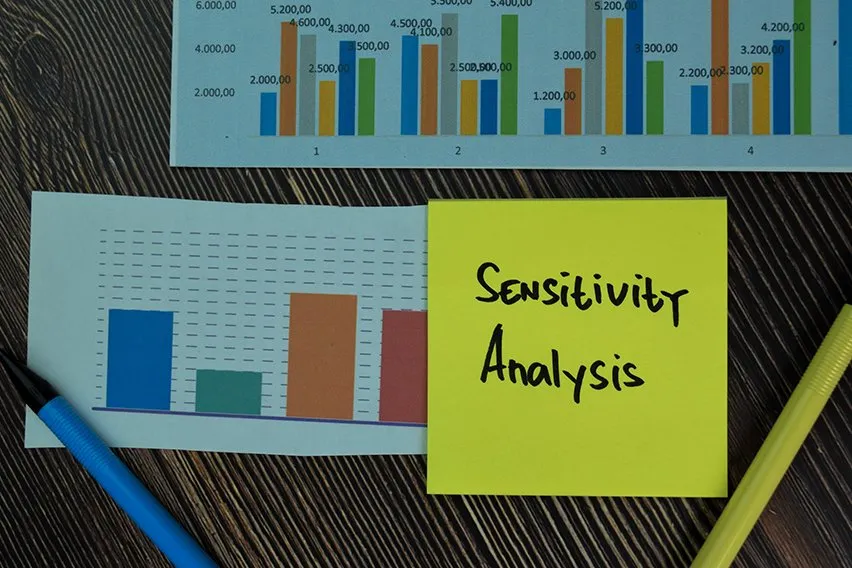An Overview of Sensitivity Analysis

When you’re a business, a lot of the reasons behind the operation are based on observational studies. You can observe the way that things affect your business, and then react to them. While observed association can help your business, there is a mathematical model that may help more. This model is known as sensitivity analysis.
Sensitivity analyses can be conducted on a number of different aspects of your business. These studies can help you identify the relationships that drive success, or the ones that cause failure. Keep reading to learn all about sensitivity analysis, and how it can help your business!
Here’s What We’ll Cover:
How Does Sensitivity Analysis Work?
Performing a Sensitivity Analysis
Sensitivity Analysis is Not the Same as Scenario Analysis
Best Practices for Financial Sensitivity Analysis
Why Should Sensitivity Analysis be Used Over Other Financial Models?
What Are Some of the Downfalls of Sensitivity Analysis?
What Is Sensitivity Analysis?
Sensitivity is a complex model based on different relationships in your business. It’s also known as the what-if model, or a simulation study. This statistical model estimates the effects of different variables on one another. In the model, you have several different variables. Let’s define them all below before continuing:
- Independent Variable: The variable that can be manipulated in the model. Also known as the cause.
- Dependent Variable: The variable that is affected by the changing independent variable. Also known as the effect.
- Input Variable: Another term for the independent variable.
- Output Variable: Another term for the dependent variable.
- Confounding Variable: A third variable that affects the independent and dependent variables.
- Continuous Variable: A variable obtained by measuring.
- Discrete Variable: A variable obtained by counting.
As you can see, there are a number of different variables present in the sensitivity analysis model. Some are called by other names, while others cannot be defined until the analysis is completed. This makes sensitivity analysis a very complex process. Because of its complexity, sensitivity analysis often has to be set within specific boundaries. This prevents the analysis from being unable to be performed.

How Does Sensitivity Analysis Work?
Sensitivity analysis focuses on specific variables. These variables are also known as target variables. The model is used to determine how these variables are affected by specific input variables. This statistical model is a method of predicting the outcome of a decision when certain variables are applied.
In many of the experiments or models we used growing up, the focus was on one variable. The variable was then subjected to different tests using independent variables. In this model, the process is more complex. These financial models need analysts to create a set of variables, then simulate the circumstances when they change. Rather than testing the variables one at a time, they are all tested and manipulated as a group. Then, each variable can be tested and altered to determine how it affects the overall outcome.
To perform a complete case analysis in sensitivity analysis, both target and input variables must be analyzed. The professional that’s performing the analysis looks at these variables in two ways.
- They observe how all variables move in the analysis
- They determine how the target variable is affected by the input variable
How Is This Applicable to Business?
This form of scenario analysis is the primary analysis used to determine a few things. First, it can be used to predict share prices for public companies. There are a number of different variables that affect the prices of a company’s share. For example, company earnings and the number of shares outstanding can greatly affect stock price. Additionally, looking at a company’s debt-to-equity ratio can inform how well a company is doing. This is a large factor in the way a company’s share price moves.
When looking at stock prices, the analysis can be refined as far as need be. It can be used with any number of variables that may be important to the company, as well as the stock. Different assumptions can be reached by using different variables in the analysis. That’s why it requires a financial expert to execute the analysis.
While this seems like a limited view when it comes to business, the possibilities are endless. In the end, sensitivity analysis is used specifically for forecasting. It can be used to predict any number of financial scenarios for a company. What it comes down to is understanding the variables surrounding the business. Then, the only information you need to get started is historical data. As long as the data is accurate, then you can start to make assumptions about your business.
Performing a Sensitivity Analysis
If you’re considering performing your own sensitivity analysis, follow the steps below. These will help guide you through performing the analysis.
Step 1: Establish a Base Case
There are three common scenarios in every sensitivity analysis. These are labelled:
- The Best Case: The scenario with the highest potential outcome.
- The Worst Case: The scenario with the largest potential downside.
- The Base Case: The scenario that sits between the best and the worst cases.
The first thing an analyst must do is identify these three cases. Then, the most prevalent independent and dependent variables must be identified. These are the variables that have the most impact on the outcome.
Step 2: Determine the Variable Inputs
When it comes to business, input variables can be any number of things. They can be inputs, or outputs, depending on the scenario. Here are some of the most commonly used variables in each category:
Inputs
- Cost of goods sold
- Debt financing
- Labour and wages
- Customer foot traffic
Outputs
- Cash flows
- Internal rate of return
- Net profits
- Net present value
For example, one of the outputs on our list is cash flows. There are a number of variables that determine a business’s cash flows. Some of these could be the cost of goods sold, labour, and customer retention. All of these variables can make an impact on the outcome of cash flows.
Step 3: Test the Variables
All that’s left for the analyst to do is test the variables! Variables identified should be tested one at a time. This lets the analyst measure the impact of each variable on the outcome independently. The reason behind testing the variables relates to the base case. By comparing changes to the base case, they can determine how sensitive the case is to each variable.
Testing input and output variables can be done one-by-one using the four steps below:
- Determine the independent variable you will change, and what dependent variables you will observe.
- Record the output of your base case scenario after changing the variable. Record it as a percentage. Do the same with both input and output variables, as well.
- Repeat steps 1 and 2 until all independent variables have been tested.
- Use the appropriate sensitivity formula to calculate a value for sensitivity. This determines how sensitive your base case is to each of your independent variables.
The most common formula used in sensitivity analysis is listed below:
Sensitivity = Percentage Change in Output / Percentage Change in Input
As can be determined by reviewing the formula, the larger the difference between the two changes, the more sensitive the variable. This is true, as long as the change in output is the larger of the two numbers. The closer the two numbers are to one another, the less sensitive the variable.
Sensitivity Analysis is Not the Same as Scenario Analysis
It’s important to realize that while they may sound similar, sensitivity and scenario analysis are not the same. Sensitivity analysis is used to determine the impact a range of variables will have on a given outcome. The focus of sensitivity analysis is maintained on the way that the inputs affect the output. The model reflects that, and focuses on the different variables. These variables can be isolated, then the possible outcomes are recorded.
However, in scenario analysis, the focus is on a specific scenario. Rather than determining what the variables could be, the scenario defines them. The variables that affect outcome align with the scenario being played out. This is a very different situation.
For example, let’s say the outcome being targeted is stock price. The sensitivity analysis isolates all variables that can impact stock price. Then, it analyzes what those variables could be to reach the outcome in question. This can be used to predict future stock prices. However, the scenario analysis looks a bit different. The scenario affecting the stock price becomes a stock market crash. Scenario analysis simulates this situation, and aligns the variables to meet it. It then determines the outcome of the targeted variable in question.
When you take a step back and look at it, you can see that sensitivity analysis helps an analyst find the possible variables creating the impact. Scenario analysis sets variables, then determines what the impact will be. In one model, the outcome already exists, while in the other it is being predicted.
Best Practices for Financial Sensitivity Analysis
When it comes to performing a sensitivity analysis, there are a few best practices that should be followed. These ensure that the analysis is being performed, and presented, in a way that makes sense.
Layout and Structure
Sensitivity analysis is largely dependent upon layout and structure. If the layout is messy, or the structure is out of order, it will be harder for all parties to understand it. No matter what program you’re using for your analysis, it should be easy to read and organize.
Illustrate the Method Used
There are two methods used in sensitivity analysis. These should be labelled clearly, so that the users understand how you came to the conclusions you found. The two methods are:
- The Direct Method: Substituting different numbers into an assumption in a model
- The Indirect Method: Inserting a percentage change in the model rather than a value
Why Should Sensitivity Analysis be Used Over Other Financial Models?
This is one of the best questions surrounding sensitivity analysis. Because the model seems so complex, many people are concerned about their ability to use it. This shouldn’t be the case, however. In fact, sensitivity analysis should be used more often! We’re going to cover all the reasons why you should use the what-if model.
Sensitivity Analysis Provides an In-Depth Look
One of the biggest strengths of sensitivity analysis is the in-depth look it provides. The depth of the financial data required allows for a full view of a company before the analysis even happens. This data allows for more accurate predictions, and it leads to better decision making for your business.
There Are No Limitations
Many other model estimates require specific model parameters. The beauty behind sensitivity analysis is the way that it encompasses all factors. This means that you’re left with no unresolved confounding variables, or unmeasured confounders. In other forms of analysis, the results aren’t necessarily realistic. This is because the unmeasured variables tend to create an impact that isn’t calculated. This means that sensitivity analysis takes all variables into consideration.
Decision-Makers Can See How to Improve Easier
All of the data used in the sensitivity model is based on accurate historical data. Because of this, it provides another look at a company’s shortcomings, both past and present. This encourages better decision-making moving forward. Because all of the data is in front of decision-makers, they don’t have to worry about looking further into the past.
Predictions Are More Accurate
Again, we come back to the fact that this form of analysis is based on real information. Therefore, the predictions are more likely to be accurate! Other models don’t rely on past data. Rather, they only use present information, then make assumptions based on outside factors. By focusing on historical figures that pertain to your business, the forecasting driven by the analysis will be more reliable.
Financial Sensitivity Analysis Adds Credibility to Other Models
While this form of analysis may not be the first to look at, it can provide supporting proof to other financial models. It can be used with any other type of financial model, and can be used to support the model’s claims. It can also be used to determine that a model is wrong, allowing you to re-evaluate. Sensitivity analyses can be used in a number of ways to support the decisions being made in a business.

What Are Some of the Downfalls of Sensitivity Analysis?
While sensitivity analysis is a strong component of many financial models, it also has some drawbacks. This is natural, of course, but knowing what the issues are may influence you to use the analysis sparingly.
Sensitivity Analysis Requires More Resources
This is true in a number of ways. Because of all of the data required, you generally need more computing power. This power is needed because math can become very sophisticated. In addition to this, a thorough sensitivity analysis needs time. The time used for drawing conclusions from sensitivity analysis could be used for other purposes. More time also means more money. The expertise required for sensitivity analysis tends to be out of reach for many individuals. You’ll need to hire a financial analyst, or an economist, depending on your focus point. The resources are varied, and are a must if you want the analysis done right.
You Need Historical Data
Because financial sensitivity analysis needs historical data, it means that only aged companies can use it. When using sensitivity analysis for business purposes, you have to have data from previous operations. This is one thing that cannot be compromised when using the method. Therefore, if you’re running a new business, you can’t use this form of analysis reliably. Additionally, if your business hasn’t compiled enough data from operations, you’ll also have a hard time. A lack of data can lead to less accurate predictions.
Sensitivity Analysis is Limitless
This can become more of a problem than it is an advantage in some cases. Sensitivity analysis has to be set within specific parameters. If it isn’t, then the variables and the data can get out of hand. If you’re constantly thinking of something else to add to the model, then you may never perform it fully. The limitless possibilities associated with variables can also lead to choice paralysis. When the human brain is given too many choices, it’s shown that it becomes harder to make a decision. This can happen during sensitivity analysis if you don’t know what variables are the most important. Limiting your scope is a must.
Sensitivity Analysis is Based on Assumption
Because all variables are based on historical data, they are also based on assumption. Assumption can break down in terms of reliability, especially if you don’t have a handle on the process. When this happens, you find that your predictions come true less often than they should. There are alternative assumptions that can be made, based on present data. However, these require a different set of variables and datasets.
Key Takeaways
When it comes to sensitivity analysis, there are many contributing factors. That is one of the model’s biggest strengths, as well as its largest downfalls. When you’re preparing to perform a sensitivity analysis, make sure that you have clearly defined cases, as well as variables. Remember, it isn’t the same as scenario analysis, as well. The variables are being altered, not the outcomes. If you’re looking for more information like this, visit our resource hub! It’s full of financial information for professionals and enthusiasts alike!
RELATED ARTICLES

 What Is Compensating Balance? Definition & Example
What Is Compensating Balance? Definition & Example What Is an Oligopoly? Definition, Characteristics & Examples
What Is an Oligopoly? Definition, Characteristics & Examples What Is Demand-Pull Inflation? Definition & Examples
What Is Demand-Pull Inflation? Definition & Examples Cost Pull Inflation: Definition, Examples & Causes
Cost Pull Inflation: Definition, Examples & Causes What Is Aggregate Demand: Definition, Formula & Components
What Is Aggregate Demand: Definition, Formula & Components What Is Consignment Stock or Inventory & How Does It Work?
What Is Consignment Stock or Inventory & How Does It Work?